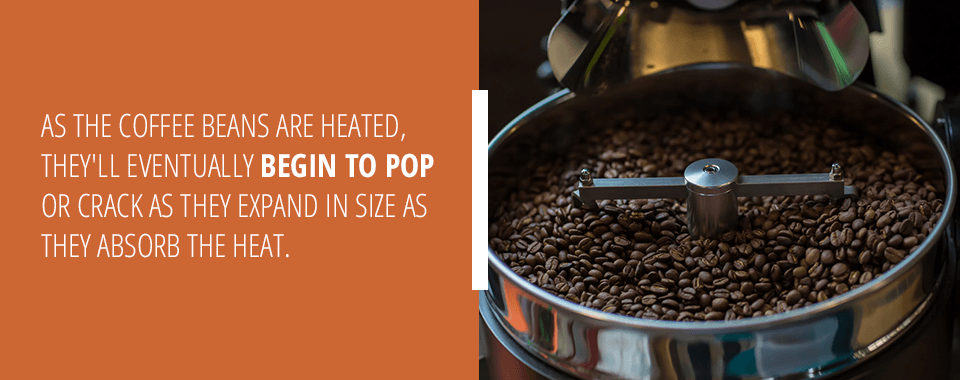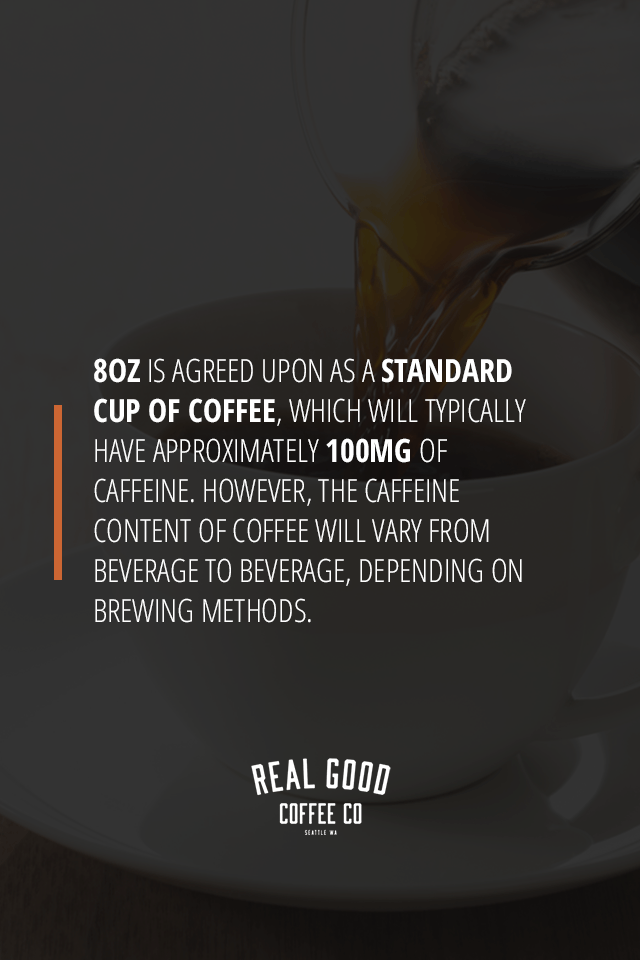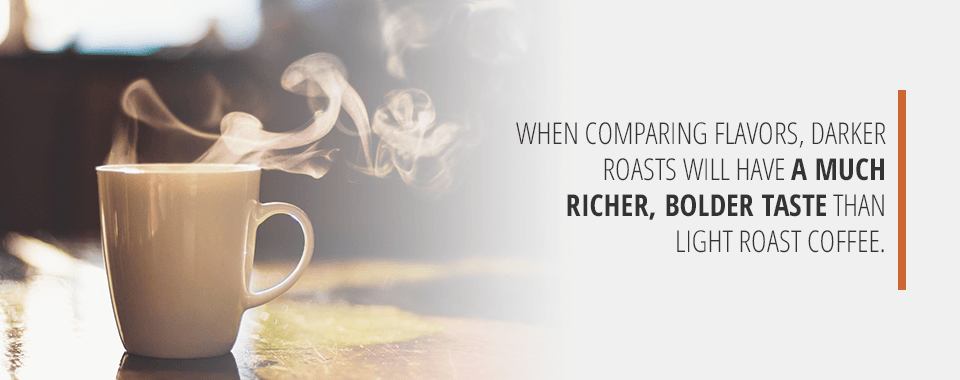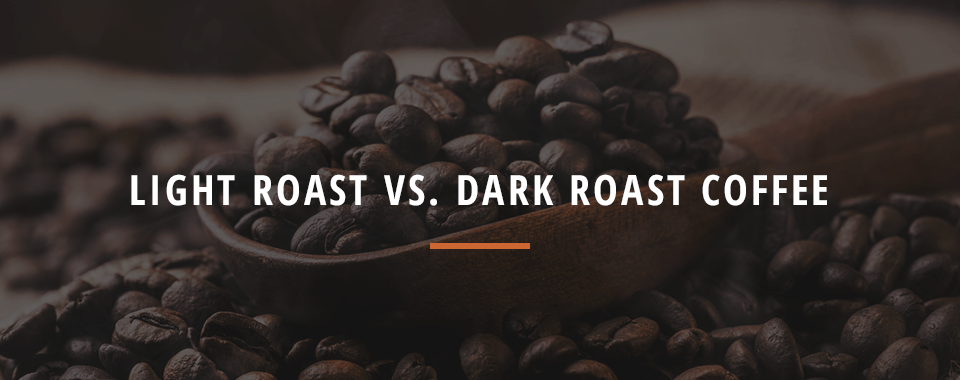
Coffee comes in many forms, but before your brew is mixed into a beverage, it goes through a roasting process that can substantially impact its flavor. For some coffee drinkers, the difference between light roast and dark roast is more than just a taste preference.
At Real Good Coffee Company, we appreciate how the science of roasting coffee influences its caffeine content, bitterness, taste, strength and acidity. Whether you're an aspiring coffee aficionado or if you'd simply like to know more about the different types of roasts, we've created this helpful light roast vs. dark roast guide to tell you everything you need to know.
New Email Subscribers Receive 10% Off →
What to Know About Pre-Roasted Coffee
Before we talk about the different types of roast, there are a few things you need to know about the coffee beans themselves — specifically how their initial makeup is changed through the roasting process. Raw coffee beans are green. They smell earthy and grassy, nothing like the typical coffee aroma you sense after they're prepared. Green coffee beans are heavier than roasted beans because their moisture hasn't been lost to the roasting process.
Coffee beans begin to darken as they absorb heat during the roasting process. Although beans from various regions have different chemical compositions, their hues will only vary slightly as they're roasted. The shade of brown produced is a common feature used to categorize light, medium, medium-dark and dark roast coffees. These categories are then further identified by roast names such as French, Italian and City.
Light Roast Coffee Features
Light roast beans have a light brown color, and they'll have no oil on their surface because they haven't roasted long enough for the oils to reach the surface. They'll have a fruity, grassy smell, and the flavors of their origin will be more distinct. Beans are considered medium roast when they begin to turn medium brown, at which point they'll have a sweeter taste and achieve a balanced level of aroma, acidity and flavor.

As the coffee beans are heated, they'll eventually begin to pop or crack as they expand in size as they absorb the heat. The cracking happens between approximately 350 and 400 degrees Fahrenheit when the beans must begin releasing the heat. This first crack then allows the beans to continue absorbing heat until they crack again. Light roasted beans are finished after the first crack occurs.
What types of coffee beverages are light roast beans used in? Technically, you can use dark or light roasted beans in any type of coffee drink. In many cafes, light roasts are used for pour-over and drip brews because these brewing processes bring out more flavors in the beans. Your own preference may be different than another's, which is why we always encourage coffee drinkers to prepare their beverage however they see fit.
When should you choose light roast coffee? If you like a thinner body to your beverage with delicate flavors, light roast is for you. When it comes to tasting the many distinct flavors of coffee, we suggest that coffee fanatics learn about the Coffee Taster's Flavor Wheel and the World Coffee Research Sensory Lexicon. These two resources will help you describe even the most subtle flavors and aromas in every cup.
Dark Roast Coffee Features
Dark roast coffee beans will have a shiny black color with an oily surface. Unlike medium-dark roasts that have a bittersweet taste, dark roasts will have a substantial bitterness to their taste. This is also because the flavors from the bean's origin have been lost to the roasting process. Medium-dark roasts will be rich, dark and somewhat oily in appearance, though not as shiny dark roast beans.
While light roasted beans are heated to a temperature around 400 degrees Fahrenheit, dark roasted coffee beans are heated to a temperature between approximately 460 and 480 degrees Fahrenheit. These beans will conclude the roasting process after the second crack.
Beans that are medium-dark roasted are usually heated to levels between 437 and 446 degrees Fahrenheit, around the time when the second crack is starting to form. Medium-roasted beans may be known as City or Full City roasts, while dark roasts are called French or Italian roasts.
We encourage all coffee drinkers to brew their batch however they please, but there are instances in which dark roast coffee beans are used more frequently in beverage preparation. If you walk into your local cafe, you will likely see the baristas prepare espresso and other espresso-based drinks with dark roast beans.
The reduced acidity of dark roast coffee beans pairs excellently with drinks that include milk or creams. Of course, you're welcome to enjoy a cup of dark roast coffee beans prepared via pour-over or drip brewing too.
When should you choose dark roast coffee? If you prefer a full-bodied beverage with flavor profiles that are bold and straight-forward, you might find yourself living on the dark side. One method we suggest for expanding your interest in light roast vs. dark roast is to try dark roast coffee in different beverages, then compare it to the taste of light roast beverages. Compare cappuccinos, lattes, macchiatos, mochas, americanos, espressos and discover how you prefer your dark roast!
New Email Subscribers Receive 10% Off →
Light Roast vs. Dark Roast Caffeine
Does light roast or dark roast coffee contain more caffeine? To understand the difference in caffeine levels — or more accurately, the near similarity in caffeine levels — you first need to understand how caffeine content can be influenced by the roasting process. The beans themselves, before they're roasted, can possess different caffeine contents. For example, two of the most common coffee beans — Arabica and Robusta — have caffeine contents of 1.5 percent and 2.4 percent, respectively.
During the roasting process, all beans are altered in weight and volume. Perhaps the most significant factor in the eventual caffeine content in your cup is the way these beans are measured. If they're measured by weight, then two pounds of a dark roast would have more caffeine than one pound of light roast.
However, when measured by volume, a cup of light beans would have more caffeine than a cup of dark beans because there are more, smaller light beans than in the cup with dark beans.
Along with weight and volume, the actual size of the grind will also influence caffeine content. It's been determined that the best length of time to grind your coffee beans is 42 seconds. This produces the optimal amount of caffeine, as caffeine content increases during the first 10 to 40 seconds. After 42 seconds of grinding, the caffeine content in the grind no longer increases.
How Does Caffeine Content Differ in Various Cups of Coffee?

8oz is agreed upon as a standard cup of coffee, which will typically have approximately 100mg of caffeine. However, the caffeine content of coffee will vary from beverage to beverage, depending on brewing methods.
For example, instant coffee could range from 27mg to up to 173mg of caffeine per cup, while boiled coffee could range from 160 to 240mg per cup. The beverage and preparation methods at your local cafe could also cause a standard 8oz cup of coffee to have more caffeine or less caffeine than typical.
For those who prefer to make their own coffee at home or in the office via coffee pods like Coffee Pods and Nespresso Pods, you should note that the caffeine content will differ from brand to brand and even product to product. For instance, a dark or light roast Keurig Coffee pod could have between 75 and 150mg of caffeine. A standard pod from a Starbucks cup for Keurig could have 130mg of caffeine for an 8oz cup, while a Verismo pod could have 45mg for a 12oz cup.
Light Roast vs. Dark Roast Coffee FAQ
Light roast vs. dark roast coffee — are you still unsure of which roast is right for you? Whether you choose your morning cup based on taste or if you prefer to ingest the brew that provides the most amount of caffeine, you may still desire a little more information regarding what makes these types of roast different. At Real Good Coffee Co., we want to provide our customers with the best brew possible. Here are a few of the questions most commonly asked by our customers about dark roast vs. light roast:
Is Light Roast or Dark Roast Coffee Healthier?
Coffee isn't just a flavorful beverage that makes every morning magnificent — it's also a drink that provides a wealth of health benefits. From helping reduce calcium in your heart and burning body fat to improving your memory and preventing diseases, every cup does your body good. However, there are no notable health benefits of drinking light roast coffee over dark roast coffee.
Which Coffee Has More Caffeine: Light Roast or Dark Roast?
Does dark roast have more caffeine, or does light roast have more caffeine? Many people believe that a dark roast blend will have more caffeine than a light roast blend, but this is a common misconception. Caffeine levels are influenced by a variety of factors, including the type of coffee plant the bean comes from.
Typically, light roasts will have more caffeine than dark roasts, as more caffeine is burned off as the beans are roasted for longer periods of time. However, it's important to remember that the difference in caffeine levels is slight, as the caffeine is chemically stable throughout the process. The changes in caffeine levels are due to the changes in the density and size of the beans after the roasting process is finished.
Is Light Roast or Dark Roast Coffee Stronger?

Coffee drinkers define the "strength" of coffee in a few different ways, including taste, bitterness and caffeine content. When comparing caffeine content, light roasts are "stronger." When comparing flavors, darker roasts will have a much richer, bolder taste than light roast coffee.
Lighter coffee will retain more flavors than dark, offering a more distinct taste if you compare light roasted beans from different regions. Of course, the taste will also depend on the preparation method you drink your coffee — via cold brew, espresso, cappuccino, etc.
Is Light Roast or Dark Roast Coffee More Bitter?
Light roast coffee is usually less bitter tasting than dark roast coffee. However, there are other factors that could influence the bitterness of the finished cup of coffee, including errors in the preparation method. Time, temperature, quality of the beans, coffee-to-water ratio, grind size and cleanliness of brewing equipment could all cause a cup to taste more or less bitter than you prefer.
Do Light Roast and Dark Roast Coffee Taste Different?
Light roast and dark roast coffees will have different tastes. This should come as no surprise — even a light roast batch prepared by one roaster may have a different taste than a light roast batch prepared by another roastery. Light roasts will have more distinct flavors, while dark roasts will have less, but more robust, flavors.
You may taste more differences between light and dark roast coffees when you compare each of them in different beverages such as mochaccinos, flat whites and even in Irish coffee.
Do Light Roast and Dark Roast Coffee Have Different Acidity?
The acidity of coffee — that is, the acidic taste of a flavor profile, not the actual acidity of the coffee measured in pH level — can be influenced by many factors including where the beans are grown, how they are processed and how they are roasted. Generally, coffee beans grown at higher altitudes will taste more acidic. Darker roasts have less acid than lighter roasts. The preparation method that will reduce the acidity of coffee the most is cold brewing.
What Makes Medium Roast Coffee Different From Light Roast and Dark Roast Types of Coffee?
Both medium roasts and medium-dark roasts have different features than light and dark roast coffees. A medium roast will have a stronger flavor than a light roast, while a medium-dark roast will have a bittersweet aftertaste. During the roasting process, medium beans will have a medium brown coloring and not be oily, while the medium-dark roasts will have a much darker color and a mildly oily surface.
Real Good Light Roast and Dark Roast Coffee
Light roast vs. dark roast — which is better? Brew a batch of each and decide for yourself! At Real Good Coffee Co., each of our delicious blends is made with 100 percent Arabica whole beans, freshly roasted in our Seattle roastery and shipped to your front door. Try the smooth taste of our Breakfast Blend Light Roast and pick up a bag of our Dark French Roast or Organic Dark Roast so you can discover which roast is right for you. Both roasts are also available in Coffee Pods and Nespresso pods for easy at-home brewing.
Order a batch of freshly roasted coffee from Real Good Coffee Company and settle the light roast vs. dark roast coffee debate right in your kitchen.








